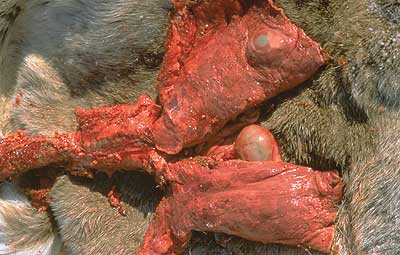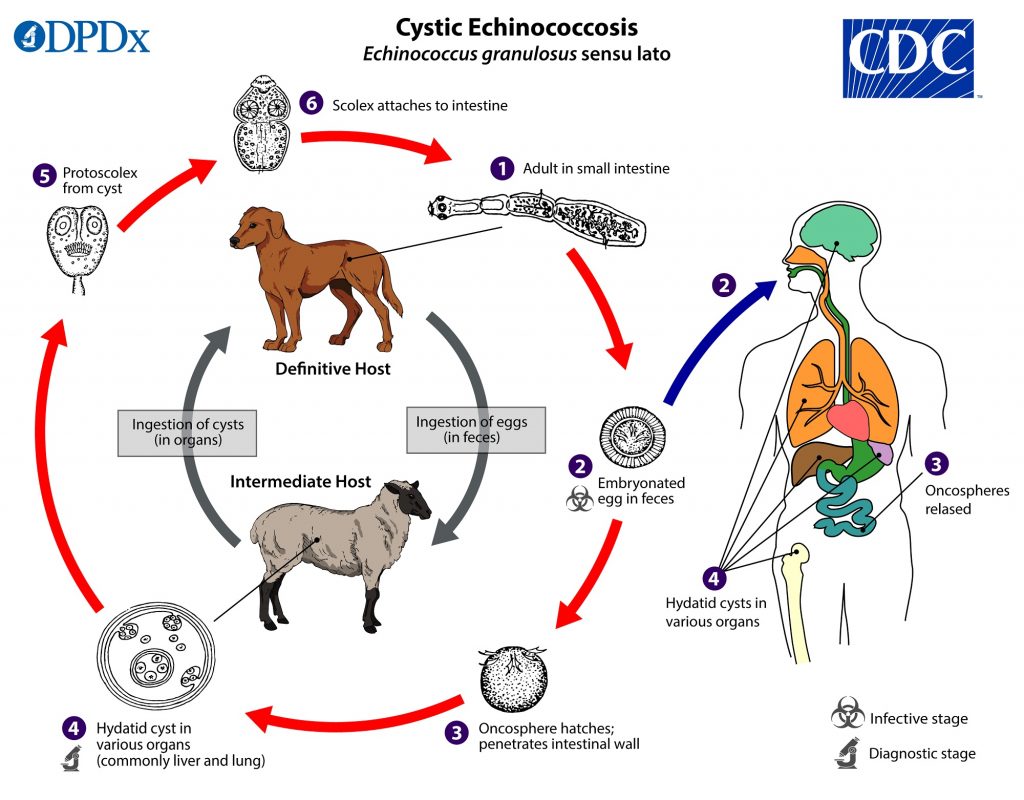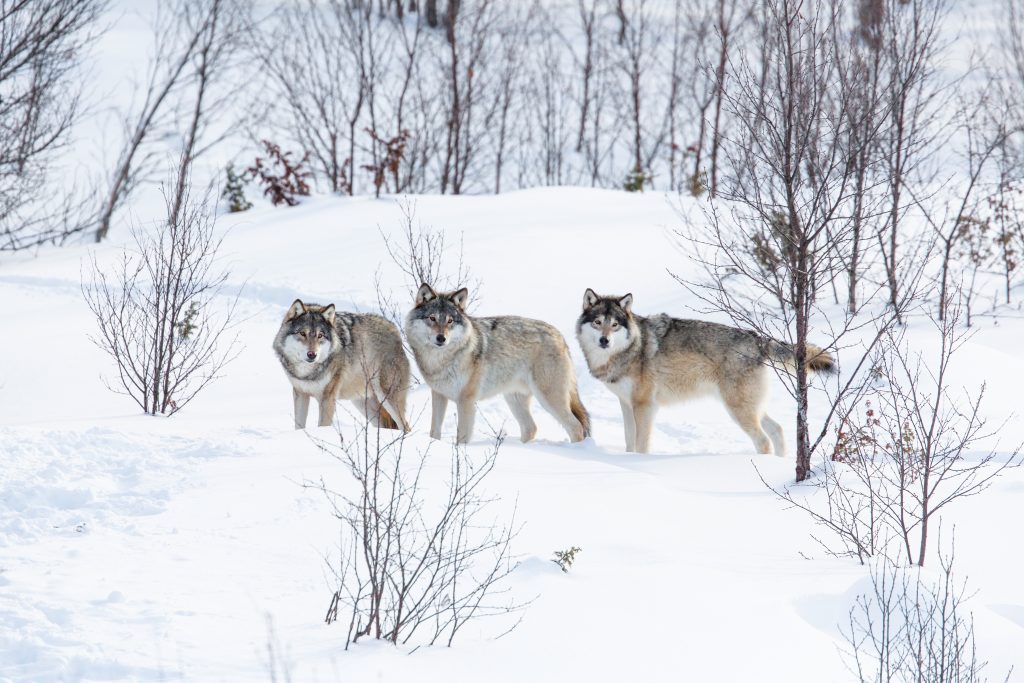by the Center for Human-Carnivore Coexistence (5/20)
Key Points….
- Chronic wasting disease (CWD) is a contagious and fatal neurological disease found in deer, elk, and moose in Colorado. Selective predation by wolves on sick and diseased animals may help limit CWD in big game, but no field study has tested this prediction.
- Hydatid disease is caused by the Echinococcus tapeworm. Canines such as wolves, coyotes, foxes, and domestic dogs are the definitive host, and ungulates such as deer, elk, moose, and domestic livestock are intermediate hosts. In rare circumstances humans may be infected by accidently ingesting eggs, but direct human infection from wolves is extremely unlikely.
- Dogs and wolves are closely related and also can share many of the same parasites and diseases. Dogs are much more likely to infect wolves than vice-versa.
How might wolves affect chronic wasting disease in elk and deer in Colorado?

Chronic wasting disease (CWD) is a contagious and fatal neurological disease found in deer, elk, and moose. It is caused by the transmission of an abnormal protein called a prion. CWD is relatively widespread in Colorado.
Wolves are predators that chase prey. Wolves tend to target slower, more vulnerable individuals, including sick and diseased animals.1,2 One study developed a mathematical model predicting that selective predation by wolves would result in a more rapid decline in CWD in deer compared to hunting by humans.3 The model suggested that wolf predation may help limit CWD. There has been no field study to test this prediction. However, wolf predation has been shown to help control disease (tuberculosis) in wild boar in Spain.2
Insight can be gained from other predators. Studies in the Front Range of Colorado showed mule deer killed by mountain lions were more likely to be infected with CWD than mule deer killed by hunters.4 This suggests that mountain lions select infected animals when targeting adult deer. Such selective predation by mountain lions, however, did not limit CWD transmission in deer populations with high infection rates.5 Unlike wolves who run when hunting, mountain lions are considered “ambush” predators that sit and wait for prey to pass. Such predatory behavior might make them less likely to detect sick animals compared to wolves.5
When carnivores eat infected prey, CWD prions can remain infectious in carnivore feces.6 But, canines appear to be naturally resistant to prions.7 We therefore would not expect the number of prions to increase in their digestive tracts. In fact, CWD prions may be degraded as they pass through the digestive system.6 While predation may not eliminate CWD from deer or elk populations, predators that selectively prey on infected animals would be expected to reduce the number of infections. This would be more likely in areas where wolves are well-established.
What is hydatid disease and can wolves spread it to humans?

Hydatid disease is caused by tapeworms in the Echinococcus genus.8-12Echinococcustapeworms require two hosts to complete their lifecycle. Definitive hosts support adult tapeworms. Domestic dogs and wild canines (e.g., coyotes, foxes, and wolves) are definitive hosts. Intermediate hosts support the immature (cyst) form of the tapeworm. Several species can be intermediate hosts, including small mammals (e.g., rodents) and ungulates (hoofed animals), including both wild ungulates (e.g., deer, elk, moose) and domestic livestock (e.g., sheep, pigs etc.).8,9
Tapeworms need both the definitive and intermediate hosts to complete their life cycle (Figure 1). The adult tapeworm lives within the intestines of the canine and releases eggs into the environment via canine feces. The intermediate host then ingests the eggs by eating contaminated vegetation. The cycle is completed when a canine eats the infected organs of an intermediate host.

North America has multiple wild and domestic cycles of tapeworm infection. The wolf/ungulate wild cycle has been documented since the early 1900s.8-10 The species of tapeworm most commonly found in wolves is Echinococcus canadensis. Recently, E. canadensis was confirmed as regularly cycling in wolves and wild ungulates in western North America, with infections present in 30-60% of wolves tested.9,10 E. canadensis has been documented in Colorado.11 In 2017, a hydatid cyst was identified in a Colorado moose. This case occurred in the apparent absence of resident wolves, suggesting other canids may have been involved. In 2020, E. canadensis eggs were identified in feces from gray wolves that migrated into northwestern Colorado.11
Humans may be infected from accidentally ingesting tapeworm eggs. Infections are typically from the species of tapeworm (E. granulosus) in the domestic cycle between dogs and livestock (often sheep or pigs; Figure 1).8,10,12 People are infected from interaction with working or companion dogs with eggs in their feces or on their paws or fur. However, human infection is rare in North America. There have been no documented human cases of hydatid disease originating from within the United States for several years, although some people have acquired infection traveling abroad.8
Direct human infection from wolves is therefore extremely unlikely. Also, the hydatid disease caused by E. canadensis is considered relatively benign in comparison to those infections arising from the domestic cycle between dogs and livestock.8,10
There are several basic precautions that can minimize the risk of human infection. Avoid touching or handling feces of wild canines. Hunters should wear gloves when field dressing carcasses and wash hands thoroughly. Contact with or consumption of the hydatid cysts in the organs of ungulates can be a source of infection to domestic dogs. To minimize risk of infection, dog owners should prevent their dogs from consuming ungulate carcasses and should regularly deworm their dogs.
Can wolves and domestic dogs transmit diseases to one another?
Dogs and wolves are closely related and can share many of the same parasites and diseases.13 Dogs are much more likely to infect wolves than vice versa. Dogs are the world’s most common carnivore14 and typically greatly outnumber wolves.15,16 Thus, diseases can be maintained in dog populations and can then spill over to wolves.13 Also, diseases in wolves and dogs can occur in other wildlife, which often outnumber wolves too. So, the risk of dogs being infected by wolves is low.
Wolves that are deliberately released during restoration programs are typically vaccinated against common canid diseases and treated with antiparasitic drugs. Such was the case for wolves restored to Yellowstone National Park.17 Upon release, wolves therefore should be healthy, but can subsequently contract diseases and parasites when exposed in their new environment.

Rabies, parvovirus, and distemper can be particularly impactful to wolves. Rabies is a fatal viral disease that infects the central nervous system.18 Rabies has occurred sporadically in wild wolves globally.13 It is rare in North American wolves, with only infrequent accounts in Alaska and Canada.19,20 When rabies outbreaks do occur, it can result in local declines in wolf numbers.13,19-21 However, wolves are unlikely to be a long-term reservoir host for rabies.13 Most incidents of rabies occur in other wildlife such as raccoons, skunks, foxes, and bats.13,18 Wolves can contract rabies from other species, including dogs. For example, dogs appear responsible for transmitting rabies to endangered Ethiopian wolves.14, 22,23 This caused massive outbreaks in the wolf population.
Distemper and parvovirus (“parvo”) are contagious viral diseases that can infect both wolves and dogs.24,25 Parvovirus is primarily spread from direct contact and contaminated feces. Distemper is typically spread through airborne exposure from sneezing or coughing. Dogs can transmit these diseases to wolves.13,26 For example, an outbreak of parvovirus in wolves in Isle Royale National Park likely came from dogs.27,28 Distemper outbreaks in Ethiopian wolves also likely originated with dogs.22,23 Distemper and parvovirus also have been detected in wolves in Yellowstone, Banff, and Jasper National Parks.29-31 However, dogs are likely not playing an important role in these areas. Rather, the diseases are likely circulating in other wild carnivores (e.g., raccoons, skunks, coyotes, and foxes) in and around the Parks.
External parasites can also infect both wolves and dogs.13 For example, wolves in Alaska have been infected by lice introduced by dogs.32 Dog lice can impact the health of individual wolves but is not considered a threat to wolf populations. Sarcoptic mange – a skin disease caused by parasitic mites – can also infect both wolves and dogs. However, there is no indication of transmission of mange between dogs and wolves.13 Rather, wolves are more likely to be infected from wild canids, such as foxes, coyotes, and other wolves.17,33,34 Mange outbreaks can cause local declines in wolf populations.
References
- Mech L. D. and Peterson R. O. 2003. Wolf-prey relations. In: Wolves: behavior, ecology and conservation. L. D. Mech and L. Boitani, eds. University of Chicago Press, Chicago: 131–160
- Tanner, E., White, A., Acevedo, P., Balseiro, A., Marcos, J. and Gortázar, C., 2019. Wolves contribute to disease control in a multi-host system. Scientific reports, 9(1), pp.1-12.
- Wild, M.A., Hobbs, N.T., Graham, M.S. and Miller, M.W., 2011. The role of predation in disease control: a comparison of selective and nonselective removal on prion disease dynamics in deer. Journal of Wildlife Diseases, 47(1), pp.78-93.
- Krumm, C.E., Conner, M.M., Hobbs, N.T., Hunter, D.O. and Miller, M.W., 2010. Mountain lions prey selectively on prion-infected mule deer. Biology Letters, 6(2), pp.209-211.
- Miller, M.W., Swanson, H.M., Wolfe, L.L., Quartarone, F.G., Huwer, S.L., Southwick, C.H. and Lukacs, P.M., 2008. Lions and prions and deer demise. PLoS one, 3(12).
- Nichols, T.A., Fischer, J.W., Spraker, T.R., Kong, Q. and VerCauteren, K.C., 2015. CWD prions remain infectious after passage through the digestive system of coyotes (Canis latrans). Prion, 9(5), pp.367-375.
- Stewart, P., Campbell, L., Skogtvedt, S., Griffin, K.A., Arnemo, J.M., Tryland, M., Girling, S., Miller, M.W., Tranulis, M.A. and Goldmann, W., 2012. Genetic predictions of prion disease susceptibility in carnivore species based on variability of the prion gene coding region. PloS one, 7(12).
- Cerda, J.R., Buttke, D.E. and Ballweber, L.R., 2018. Echinococcus spp. tapeworms in North America. Emerging infectious diseases, 24(2), p.230.
- Foreyt, W.J., M.L. Drew, M. Atkinson, and D. Mccauley. 2009. Echinococcus granulosus in gray wolves and ungulates in Idaho and Montana, USA. Journal of Wildlife Diseases, 45:1208-1212.
- Cerda, J.R. and Ballweber, L.R., 2018. Confirmation of Echinococcus canadensis G8 and G10 in Idaho Gray Wolves (Canis lupus) and Cervids. Journal of Wildlife Diseases, 54(2), pp.403-405.
- Colorado Parks & Wildlife. 2020. Hydatid Disease.
- Center for Disease Control and Prevention. 2020. Parasites – Echinococcosis: Biology.
- Lescureux, N. and Linnell, J.D., 2014. Warring brothers: The complex interactions between wolves (Canis lupus) and dogs (Canis familiaris) in a conservation context. Biological conservation, 171, pp.232-245.
- Vanak, A.T. and Gompper, M.E., 2009. Dogs Canis familiaris as carnivores: their role and function in intraguild competition. Mammal Review, 39(4), pp.265-283.
- Randall, D.A., Marino, J., Haydon, D.T., Sillero-Zubiri, C., Knobel, D.L., Tallents, L.A., Macdonald, D.W. and Laurenson, M.K., 2006. An integrated disease management strategy for the control of rabies in Ethiopian wolves. Biological Conservation, 131(2), pp.151-162.
- Brzeski, K.E., Harrison, R.B., Waddell, W.T., Wolf, K.N., Rabon Jr, D.R. and Taylor, S.S., 2015. Infectious disease and red wolf conservation: assessment of disease occurrence and associated risks. Journal of Mammalogy, 96(4), pp.751-761.
- Almberg, E.S., Cross, P.C., Dobson, A.P., Smith, D.W. and Hudson, P.J., 2012. Parasite invasion following host reintroduction: a case study of Yellowstone’s wolves. Philosophical Transactions of the Royal Society B: Biological Sciences, 367(1604), pp.2840-2851.
- Centers for Disease Control and Prevention (CDC). 2020. Rabies.
- Theberge, J.B., Forbes, G.J., Barker, I.K. and Bollinger, T., 1994. Rabies in wolves of the Great Lakes Region. Journal of Wildlife Diseases, 30(4), pp.563-566.
- Ballard, W.B. and Krausman, P.R., 1997. Occurrence of rabies in wolves of Alaska. Journal of Wildlife Diseases, 33(2), pp.242-245.
- Mech, L.D., 2017. Where can wolves live and how can we live with them? Biological conservation, 210, pp.310-317.
- Laurenson, K., Sillero-Zubiri, C., Thompson, H., Shiferaw, F., Thirgood, S. and Malcolm, J., 1998, November. Disease as a threat to endangered species: Ethiopian wolves, domestic dogs and canine pathogens. In Animal Conservation forum (Vol. 1, No. 4, pp. 273-280). Cambridge University Press.
- Marino, J., Sillero-Zubiri, C., Deressa, A., Bedin, E., Bitewa, A., Lema, F., Rskay, G., Banyard, A. and Fooks, A.R., 2017. Rabies and distemper outbreaks in smallest Ethiopian wolf population. Emerging infectious diseases, 23(12), p.2102.
- American Veterinary Medical Association. 2020. Canine distemper.
- American Veterinary Medical Association. 2020. Canine parvovirus.
- Beineke, A., Baumgärtner, W. and Wohlsein, P., 2015. Cross-species transmission of canine distemper virus—an update. One Health, 1, pp.49-59.
- Peterson, R.O., Thomas, N.J., Thurber, J.M., Vucetich, J.A. and Waite, T.A., 1998. Population limitation and the wolves of Isle Royale. Journal of Mammalogy, 79(3), pp.828-841.
- Wilmers, C.C., Post, E., Peterson, R.O. and Vucetich, J.A., 2006. Predator disease out‐break modulates top‐down, bottom‐up and climatic effects on herbivore population dynamics. Ecology letters, 9(4), pp.383-389.
- Almberg, E.S., Mech, L.D., Smith, D.W., Sheldon, J.W. and Crabtree, R.L., 2009. A serological survey of infectious disease in Yellowstone National Park’s canid community. PloS one, 4(9).
- Almberg, E.S., Cross, P.C. and Smith, D.W., 2010. Persistence of canine distemper virus in the Greater Yellowstone Ecosystem’s carnivore community. Ecological Applications, 20(7), pp.2058-2074.
- Nelson, B., Hebblewhite, M., Ezenwa, V., Shury, T., Merrill, E.H., Paquet, P.C., Schmiegelow, F., Seip, D., Skinner, G. and Webb, N., 2012. Prevalence of antibodies to canine parvovirus and distemper virus in wolves in the Canadian Rocky Mountains. Journal of wildlife diseases, 48(1), pp.68-76.
- Gardner, C.L., Beckmen, K.B., Pamperin, N.J. and Del Vecchio, P., 2013. Experimental treatment of dog lice infestation in interior Alaska wolf packs. The Journal of wildlife management, 77(3), pp.626-632.
- Jimenez, M.D., Bangs, E.E., Sime, C. and Asher, V.J., 2010. Sarcoptic mange found in wolves in the Rocky Mountains in western United States. Journal of wildlife diseases, 46(4), pp.1120-1125.
- Fuchs, B., Zimmermann, B., Wabakken, P., Bornstein, S., Månsson, J., Evans, A.L., Liberg, O., Sand, H., Kindberg, J., Ågren, E.O. and Arnemo, J.M., 2016. Sarcoptic mange in the Scandinavian wolf Canis lupus population. BMC veterinary research, 12(1), p.156.





